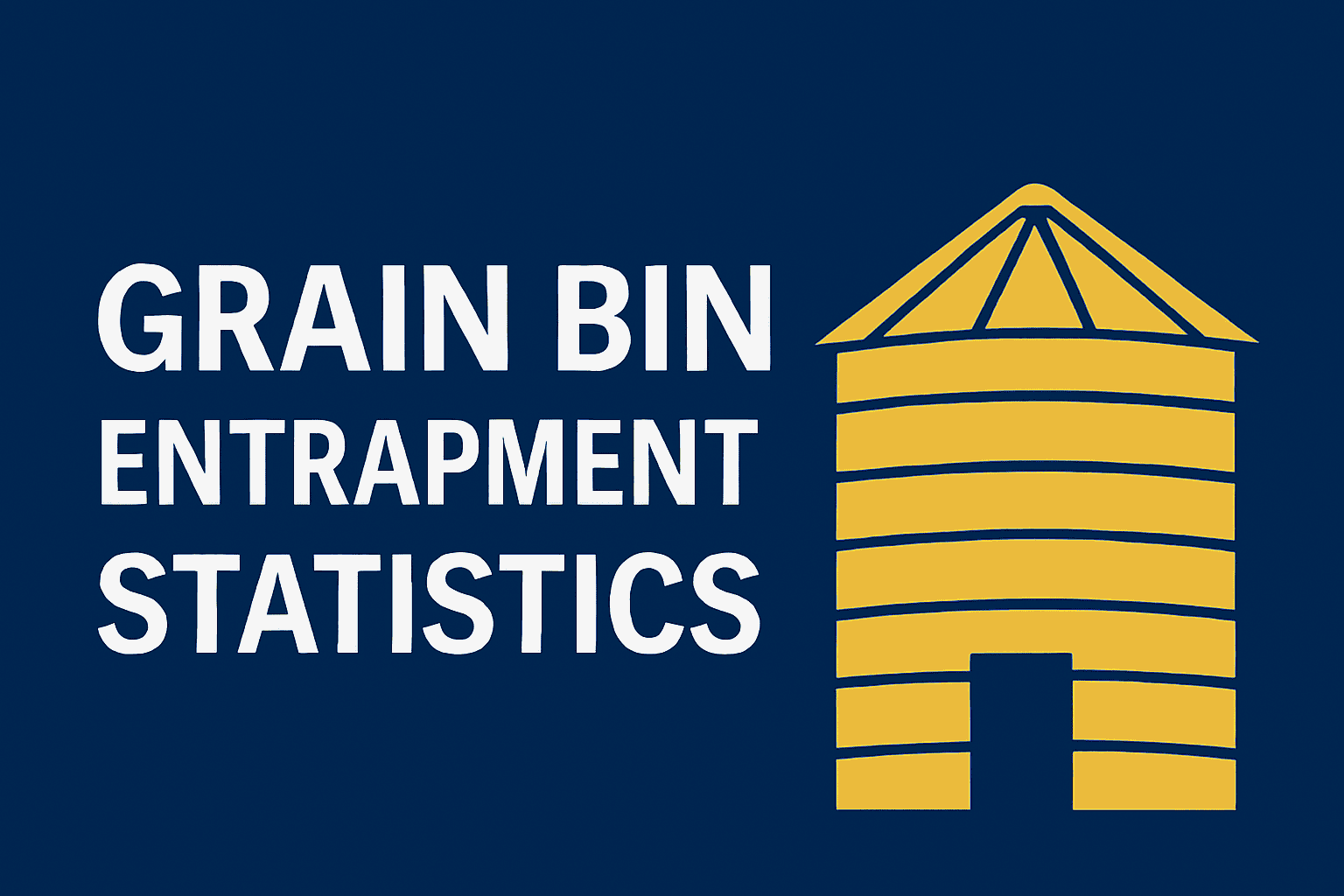
Grain Bin Entrapment Statistics and Survival Rates
Grain bin entrapment remains one of the deadliest and most preventable hazards in American agriculture. Despite advances in safety equipment and awareness, incidents continue to occur at an alarming rate—often in seconds, with tragic outcomes.
In this article, we’ll break down the latest entrapment statistics, explore survival rates, and unpack what the data reveals about who’s most at risk—and why. Whether you’re developing a safety plan or trying to protect your team, these numbers tell a story that every ag professional needs to hear.
In this study, we’ll cover the following topics:
- Entrapments Over Time: Frequency, Facility, Age, Region, Other Types of Cases
- How Grain Entrapments Happen: Out-of-Condition Grain, Flowing Grain, Breaking Grain, Lacking Procedures & Training
- Prevention and Safety: What to Avoid, Check Grain Condition, Proper Safety Equipment, Rescue Plan
The Frequency of Grain Entrapments
According to Purdue University’s 2023 Agricultural Confined Space Incident Summary, there were 27 documented grain entrapment cases in the U.S., marking a 35.7% decrease from 2022. Despite the decline in total incidents, the fatality rate rose to 59.3%, making 2023 one of the deadliest years proportionally in the past decade.
Note Data Limitations: Experts estimate that actual case counts may be 30% or more higher due to underreporting in the agricultural sector.
Trends Over 10 Years
Over the past decade, grain bin entrapments have remained a serious safety concern in U.S. agriculture. From 2014 to 2023, annual incident totals have fluctuated between 23 and 42 cases, with sharp increases in some years—most notably a 44.8% jump from 2021 to 2022. While 2023 saw a 35.7% decrease in total cases, the fatality rate remained high.
Despite improvements in rescue equipment and safety awareness, survival rates have not consistently improved. Most years still see over 50% of incidents end in death, with 2023 reporting a fatality rate of 59.3%. Entrapments continue to occur most frequently in major grain-producing states like Iowa, Indiana, Illinois, and Minnesota, highlighting the ongoing need for prevention and training.
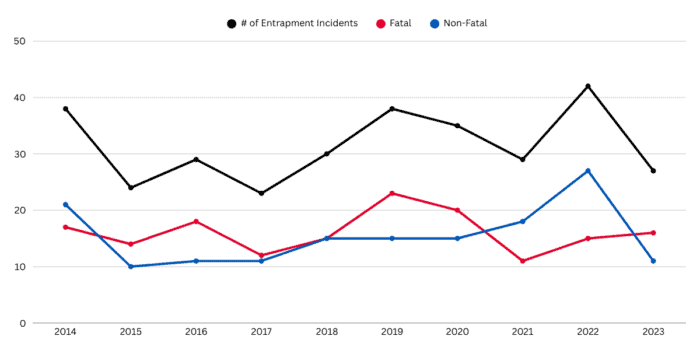
| Year | # of Entrapment Incidents | Fatal | Non-Fatal |
|---|---|---|---|
| 2014 | 38 | 17 | 21 |
| 2015 | 24 | 14 | 10 |
| 2016 | 29 | 18 | 11 |
| 2017 | 23 | 12 | 11 |
| 2018 | 30 | 15 | 15 |
| 2019 | 38 | 23 | 15 |
| 2020 | 35 | 20 | 15 |
| 2021 | 29 | 11 | 18 |
| 2022 | 42 | 15 | 27 |
| 2023 | 27 | 16 | 11 |
| Ten Year Total | 315 | 161 | 154 |
*2024 statistics have not yet been published by Purdue
Grain Bin Entrapment by Age (2014-2023)
Average Age of Victims: 56 Years Old. Most victims are not inexperienced laborers — they’re seasoned farmers. The average age of 56 suggests that familiarity with equipment doesn’t equal safety. This reinforces the need for safety reminders, even among veteran producers.
Victims Under Age 21: 20.4% of Cases. About 1 in 5 victims were under the age of 21. Many of these incidents involve family members helping on the farm or youth employees. This data underscores the importance of training and clearly prohibiting bin entry for minors.

| Year | 1-10 | 11-20 | 21-30 | 31-40 | 41-50 | 51-60 | 61-70 | 71-80 | 81-90 | Unknown |
|---|---|---|---|---|---|---|---|---|---|---|
| 2014 | 2 | 2 | 3 | 1 | 3 | 6 | 4 | 4 | 1 | 12 |
| 2015 | 0 | 1 | 2 | 4 | 1 | 4 | 3 | 3 | 0 | 6 |
| 2016 | 1 | 4 | 1 | 1 | 2 | 3 | 2 | 4 | 0 | 11 |
| 2017 | 0 | 0 | 2 | 2 | 2 | 4 | 3 | 4 | 1 | 5 |
| 2018 | 2 | 3 | 2 | 0 | 2 | 3 | 5 | 1 | 0 | 12 |
| 2019 | 0 | 1 | 2 | 3 | 1 | 6 | 5 | 6 | 1 | 13 |
| 2020 | 0 | 0 | 2 | 1 | 1 | 4 | 8 | 5 | 1 | 13 |
| 2021 | 0 | 0 | 2 | 1 | 1 | 1 | 3 | 3 | 0 | 18 |
| 2022 | 1 | 4 | 1 | 4 | 3 | 3 | 3 | 1 | 0 | 22 |
| 2023 | 0 | 0 | 2 | 0 | 3 | 3 | 5 | 2 | 1 | 11 |
| Ten Year Total | 6 | 15 | 19 | 17 | 19 | 37 | 41 | 33 | 5 | 123 |
Entrapments in “Corn Belt” Region (2014-2023)
The Corn Belt region—including Iowa, Illinois, Indiana, Minnesota, Kansas, Missouri, Ohio, South Dakota, Wisconsin, and Nebraska—accounts for the majority of grain bin entrapments due to its high concentration of grain production, storage, and handling facilities. This area consistently leads the nation in entrapment cases, making it a critical focus for prevention and safety efforts.
Top State: Iowa (55 Entrapments). Iowa reported more entrapments than any other state between 2014 and 2023. With a large number of bins on family farms and some of the highest grain production in the country, it’s a high-risk zone that needs continued focus on safety training and resources.
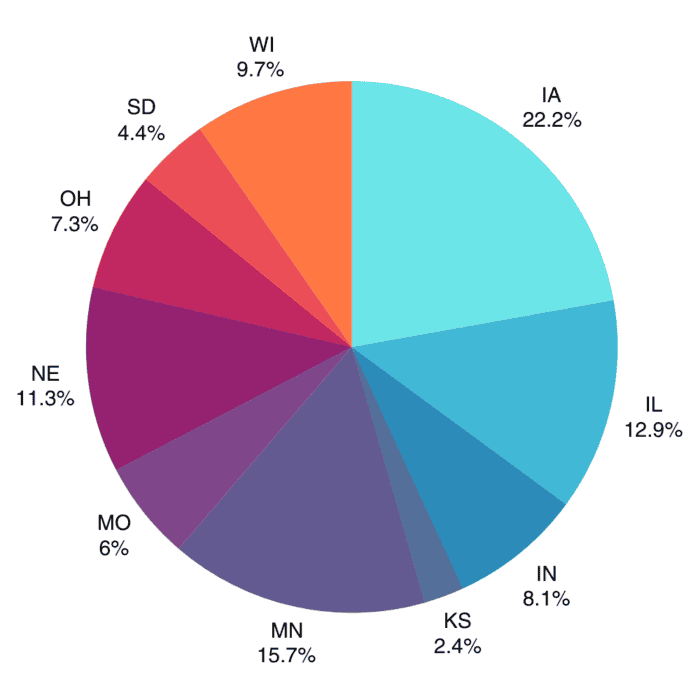
| Year | IA | IL | IN | KS | MN | MO | NE | OH | SD | WI |
|---|---|---|---|---|---|---|---|---|---|---|
| 2014 | 4 | 3 | 4 | 1 | 6 | 1 | 3 | 0 | 3 | 3 |
| 2015 | 7 | 1 | 1 | 1 | 1 | 1 | 4 | 2 | 0 | 1 |
| 2016 | 7 | 2 | 2 | 0 | 5 | 0 | 3 | 1 | 1 | 2 |
| 2017 | 7 | 0 | 1 | 1 | 2 | 0 | 1 | 1 | 0 | 3 |
| 2018 | 5 | 2 | 2 | 3 | 2 | 1 | 2 | 1 | 1 | 3 |
| 2019 | 4 | 3 | 1 | 0 | 7 | 1 | 4 | 4 | 0 | 3 |
| 2020 | 3 | 10 | 3 | 0 | 4 | 1 | 2 | 3 | 3 | 1 |
| 2021 | 4 | 5 | 2 | 0 | 3 | 2 | 2 | 2 | 1 | 2 |
| 2022 | 9 | 3 | 4 | 0 | 5 | 4 | 3 | 4 | 2 | 2 |
| 2023 | 5 | 3 | 0 | 0 | 4 | 4 | 4 | 0 | 0 | 4 |
| Ten Year Total | 55 | 32 | 20 | 6 | 39 | 15 | 28 | 18 | 11 | 24 |
Confined Space Cases by Type of Incident (2014-2023)
Confined Space Rescues: 37.1% Success Rate. Across all types of ag confined space incidents (grain bins, silos, pits), about 1 in 3 cases ends in a successful rescue. These numbers highlight the importance of proactive safety — because even well-trained responders face major challenges once someone is engulfed.
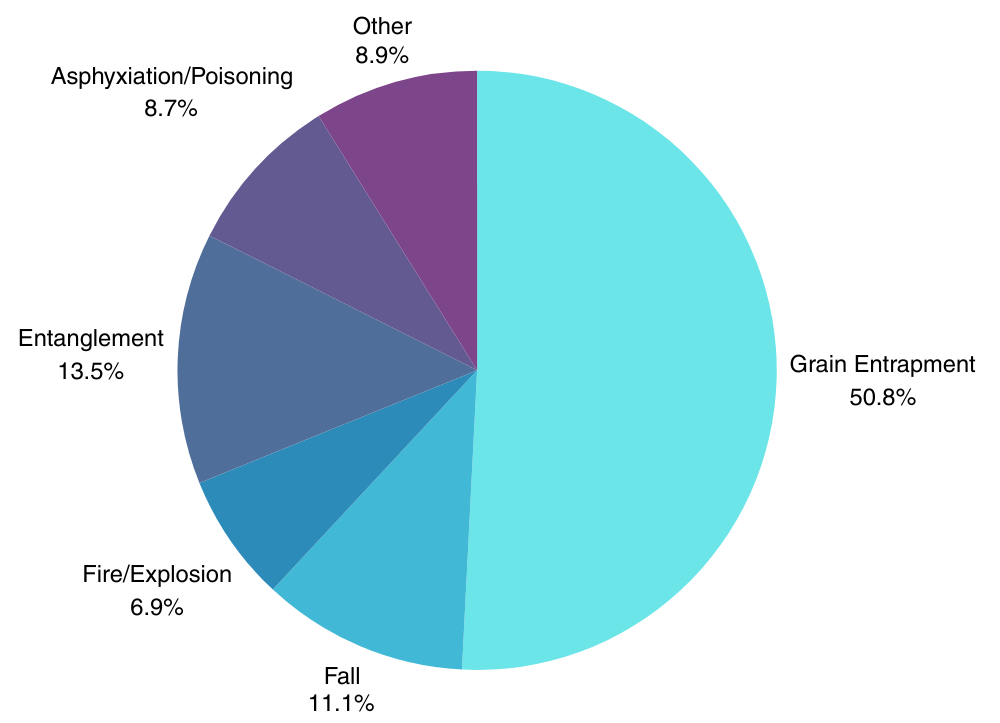
| Year | Grain Entrapment | Fall | Fire/Explosion | Entanglement | Asphyxiation/Poisoning | Other |
|---|---|---|---|---|---|---|
| 2014 | 38 | 12 | 9 | 8 | 3 | 0 |
| 2015 | 24 | 6 | 0 | 6 | 4 | 7 |
| 2016 | 29 | 11 | 0 | 8 | 10 | 2 |
| 2017 | 23 | 9 | 0 | 8 | 2 | 12 |
| 2018 | 30 | 6 | 0 | 11 | 7 | 7 |
| 2019 | 38 | 8 | 0 | 11 | 5 | 5 |
| 2020 | 35 | 7 | 0 | 12 | 4 | 6 |
| 2021 | 29 | 2 | 7 | 7 | 7 | 7 |
| 2022 | 42 | 4 | 18 | 7 | 7 | 5 |
| 2023 | 27 | 4 | 9 | 6 | 5 | 4 |
| Ten Year Total | 315 | 69 | 43 | 84 | 54 | 55 |
Historical Analysis
Grain bin entrapments have posed a serious threat to agricultural workers for decades, with Purdue University’s data tracing incidents as far back as 1964. Since then, over 1,225 grain entrapments have been documented, with annual cases fluctuating significantly based on crop conditions and storage challenges. One of the most dangerous years on record was 2010, when the U.S. saw 51 reported incidents—largely due to high-moisture harvests and out-of-condition grain that led to crusting and bridging hazards.
The Corn Belt states account for the majority of entrapments, reflecting the region’s heavy grain production and storage infrastructure. Victims are overwhelmingly male, with an average age in the 40s, though a concerning number of cases involve youth under 18. While the last decade has seen advancements in rescue tools and training—like the use of grain rescue tubes and confined space entry protocols—fatalities remain common. This underscores the urgent and ongoing need for rigorous prevention efforts, especially in high-risk regions and family-run operations where safety resources may be limited.

Why Grain Bin Entrapments Happen (And When They’re Most Likely)
Grain bin entrapments aren’t random — they tend to happen under specific storage and operational conditions. Most incidents occur when grain doesn’t flow properly, becomes crusted or spoiled, or when someone enters a bin without proper precautions to fix a blockage or unloading issue.
Two Scenarios That Lead to Entrapment
- Flowing Grain: A worker enters the bin while grain is being unloaded and is pulled under by suction forces.
- Out-of-Condition Grain: Spoiled or crusted grain can collapse unexpectedly, burying anyone trying to break it loose.
These two situations account for the vast majority of grain bin entrapments — and both are preventable with proper grain management and bin entry protocols.
Why Bumper Crop Years Are Riskier
While there isn’t a perfect one-to-one correlation between national grain production and entrapment spikes, agricultural safety experts have observed a consistent pattern: Years with large harvests often lead to increased bin entrapments.
Here’s why:
- More grain = more bins filled to capacity
- Longer storage time increases the risk of spoilage or crusted grain
- Spoiled grain leads to more bin entry — and more opportunity for accidents
For example, 2014, 2019, and 2022 were all years with large U.S. corn harvests and saw above-average numbers of entrapment incidents. That doesn’t mean the harvest alone caused them — but it created the conditions where they were more likely to happen.
“There continues to be a direct relationship between the probability of an entrapment and the presence of out-of-condition or spoiled grain.”
— Purdue Ag Confined Space Report, 2022
A Lack of Safety Equipment and Training
Another critical cause of grain bin entrapments is the absence of proper training and protective equipment. Many incidents happen on small farms where they may not have the proper equipment.
- Workers may not use lifelines, harnesses, or spotters
- Safety protocols may not be in place or enforced
- Confined space hazards are underestimated
In many cases, a harness, a second person, or basic bin entry training could have prevented a fatality.
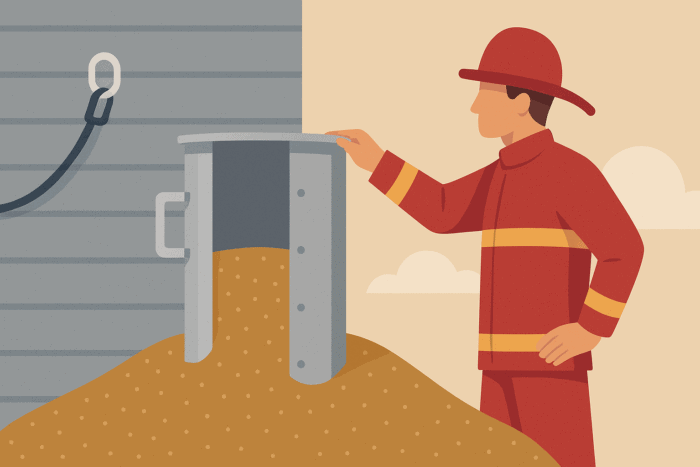
Grain Bin Safety & Prevention: What’s Working — and What Still Needs Work
Grain bin entrapments are almost always preventable. But prevention depends on education, equipment, and a culture of safety. Over the past decade, we’ve seen significant progress in all three areas — and the results are encouraging.
Every year, workers are injured or killed in grain entrapment incidents—most of which happen in seconds and without warning. The good news is that nearly all of these tragedies are preventable. By understanding the risks, following proper safety protocols, and investing in the right training and equipment, farmers and grain handlers can significantly reduce the chances of an accident.
Rescue Success is Improving
Thanks to wider distribution of grain rescue tubes and better training for rural fire departments, the survival rate in entrapment incidents has improved in recent years. In some years — like 2021 and 2023 — non-fatal entrapments actually outnumbered fatal ones for the first time in a decade.
Grain rescue tubes, when deployed quickly by trained first responders, can mean the difference between life and death. That’s why making them accessible in farming communities is critical.
Our Role in Prevention
At West Side Salvage, we believe in being part of the solution. That’s why we donate grain rescue tubes to rural fire departments across the Midwest — helping ensure they’re equipped to respond when seconds count.
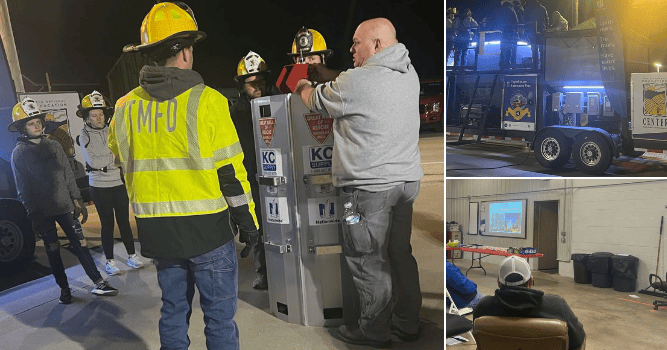
These donations are more than just equipment — they’re a commitment to protecting lives and supporting the communities we serve.
Simple Steps That Save Lives
While rescue efforts are improving, the best strategy is prevention. Here are the top ways to reduce the risk of grain bin entrapments:
- Never enter a bin alone
- Use lifelines and harnesses — properly anchored outside the bin
- Always lock out unloading equipment before entry
- Train workers and family members on bin hazards
- Monitor grain condition and prevent spoilage
- Keep youth and untrained workers out of bins
Prevention Starts Before You Open the Hatch
Improving grain quality management, using safety gear, and knowing when not to enter a bin are all part of a proactive safety culture. When that’s paired with access to life-saving equipment and trained responders, we can continue to reduce both the frequency and severity of grain bin entrapments.
Conclusion
The statistics surrounding grain bin entrapments serve as a powerful reminder of how important prevention and preparedness truly are. While survival rates have fluctuated over the past decade, the consistent threat posed by flowing grain and out-of-condition storage remains. The most effective way to reduce risk is through proactive safety protocols, regular training, and a commitment to keeping grain in good condition.
At West Side Salvage, we’ve seen firsthand how preventative maintenance, timely bin cleaning, and proper grain handling can make all the difference. Whether you’re managing daily operations or responding to an emergency, we’re here to help you operate more safely and efficiently—because when it comes to grain bin safety, doing things right isn’t optional, it’s life-saving.
References:
- Purdue Extension. (2024). Grain entrapment is the leading cause of agricultural confined space-related injuries and fatalities, researchers emphasize safety.
- Purdue University & NGFA. (2023). Summary of U.S. Agricultural Confined Space-Related Injuries and Fatalities – 2023.
- University of Minnesota Extension. Grain bin safety.
- Nationwide Newsroom. (2024). Grain bin safety program provides crucial rescue tools.
- University of Arkansas Extension. FSA1010: Grain Bin Entrapment: What If It Happens to You?.
- Purdue University (2016). Summary of U.S. Agricultural Confined Space-Related Injuries and Fatalities – 2016.
- Purdue University (2018). Summary of U.S. Agricultural Confined Space-Related Injuries and Fatalities – 2018.
- Purdue University (2019). Summary of U.S. Agricultural Confined Space-Related Injuries and Fatalities – 2019.
- World-Grain. (2021). U.S. entrapment incidents down in 2020.
- Purdue University (2021). Summary of U.S. Agricultural Confined Space-Related Injuries and Fatalities – 2021.
- Purdue University (2022). Summary of U.S. Agricultural Confined Space-Related Injuries and Fatalities – 2022.
- NSight Online. (n.d.). Choose the Right Rescue Tube for Your Operation.